The world’s most technologically advanced MBT
The T-54/55 were, in 1960, relatively rugged and proven designs, derived from WW2 ideas and concepts. But, with Western countries advancing quickly towards a new generation of battle tanks, the USSR needed to make a bold step forward from its previous designs to keep the edge. By the fall of 1959, the T-62 project was advancing fast at Nizhny Tagil, designed by a young team, and looked revolutionary with its new smoothbore gun.
Alexander Morozov, the chief engineer and father of the T-54/55 family, then headed the Kharkiv factory plant design bureau (KMDB) in Ukraine. He also sought to design the next-generation main battle tank, and also thought a new gun was the necessary upgrade around which the whole new design should revolve. This gun, the 2A46, would be derived from the new generation of Soviet AT smoothbore tracted guns, the 2A45 125 mm (4.92 in). And it would be coupled with other innovations, like an auto-loader, reducing the crew to just three, an upgraded 5DTF 5-cyl. diesel engine, and a completely new and reworked suspensions system, along with upgraded equipment.
But its development took time, and the T-62 was unveiled and mass-produced earlier. The T-64 was eventually built from mid-1960 to late 1980s and upgraded, standing apart as an elite MBT, and precursor of the second generation MBT T-72, which took a great deal from it. Its real successor came in the 1990, after the fall of USSR, with the equally advanced T-90.
Issues
The autoloader controversy
The adoption of an autoloader presented many advantages, but came with some controversy, due to the experience with the less refined T-62 autoloader. It was dangerous for the crew if the assembly quality was not optimal (rounds bouncing around, jammed mechanics), leading to serious injuries and hot poisonous gas exhausts inside the cramped turret, not to mention the problems that arose if the autoloader was inoperable for some reasons. The gunner had to manually load the gun in an uncomfortable and dangerous position, and with a very slow rate of fire (less than one per minute), critical in the heat of battle.
A crew of three
From a strict military point of view, a crew of three could be a great advantage when having limited manpower. France tested this in the 1930s with almost systematic one-man turret configurations (a tradeover due to a depleted male population and poor birth rate after the losses of the Great War), only to find that an overloaded commander was not favorable on the battlefield. A two-man turret with a commander occupied with his usual tasks allowed a three-man tank to remain fully operational and field more tanks with the same amount of trained crews.
But this came at a price, as the crew was also in charge of the tank maintenance and refueling, which was even more exhausting on the complex T-64. Moreover, these duties are also performed at the end of the operations, when the tank crew is physically exhausted, often without an officer, leading to two-men operations and less effective crews on the long run. Maintenance routine, in these cases, had a tendency to be botched or even skipped, which was paid, in return, by higher risks of mechanical failure. These aspects are further exacerbated in active combat operations.
Complexity
Unlike most Russian tanks, simple and rugged, the T-64 was a very complex and unusually care-sensitive machine. This, combined with summary maintenance habits and reduced crew, resulted in a very high breakdown rate at the beginning. The brand new suspension system, a quite advanced design, necessitated the permanent presence of teams of civilian mechanics from factories to assist the unit for the first years after its adoption and delayed a widespread adoption in operational frontline units until the 1970s, and only with proper maintenance procedures. The engine itself was also troublesome, and entire units stationed in East Germany and Hungary were sometimes depleted of 30 tanks in a single year, the equivalent of a whole battalion. Complaints numbers reached the military wing of the central committee. Alexander Morozov himself was blamed, but the military school was able to train a new generation of young officers, able to deal with all aspects revolving around this new tank. This generation was able to make the transition between the “old school mass produced” generation MBTs, to those accustomed to a fewer and high engineered third-generation main battle tanks, like the T-80 and T-90, plus better-trained crews, but the T-64 triggered all this.
The Ukrainian variants (1990-2000s)
The end of the Cold War allowed the T-64 to keep up with the latest technologies, right up to the XXIst century. These developments were greatly helped by the presence of the original factory and its numerous facilities on Ukrainian soil.
The T-64BM2
This version received a brand new 57DFM multi-fuel engine capable of 850 hp (625 kW), a new 1A43U fire control system, a new 6ETs43 autoloader and a system enabling the use of the light 9M119 AT missile (“AT-11 Sniper”). Armor is upgraded to the Kontakt 5 ERA standard.
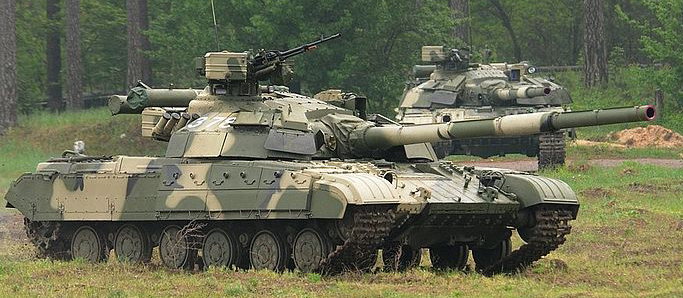
The Ukrainian T-64BM Bulat in maneuvers.
The T-64U
This model is based on the latter, but received a new 1A45 fire control system borrowed from the T-80U/T-84, the tank commander PNK-4SU and TKN-4S all-weather NV optics, and an anti-aircraft PZU-7 AA sight for the heavy machine gun. The tank commander is given the possibility to fire the gun directly if the gunner was incapacitated. The standard protection is provided by a Kontakt-5 explosive reactive armor set, and apparently upgraded only on a few prototypes. Both the BM2 and U are in the process of being re-engineered with the new 6TDF 1000 hp (735 kW) engine.
The T-64BM Bulat
Based on the BM2, this version integrates the Ukrainian designed Knozh reactive armor, a well improved version of Kontakt-5, apparently giving better overall protection against tandem warheads, and also equipped with the new Ukrainian main gun 125 mm (4.92 in) gun KBA3. It is also equipped with the advanced TO1-KO1ER night sight and compatible with the Ukrainian KOMBAT missile system, which uses tandem warheads. It basically brings the T-64B to the standard of the T-84 with “Nozh” reactive armor, 9K120 “Refleks” missile (NATO code “AT-11 Sniper”), 1A45 “Irtysh” fire control, TKN-4S commander’s sight and PZU-7 AA HMG sight plus TPN-4E “Buran-E” night vision and a 6TDF 1000-hp (735 kW) engine.
Production & variants
Due to the program secrecy, the sources are differing considerably about the total production, at least in the initial period of 1963-1967. In practice, the first T-64s had the same 115 mm (4.53 in) smoothbore gun as the T-62, but mass-production models were all equipped with the 125 mm (4.92 in) gun, compatible with T-72 ammunition. The T-64 was, however, much more complex and costlier than the T-72, and did not see much active service outside the USSR or Russia.
Experimental variants
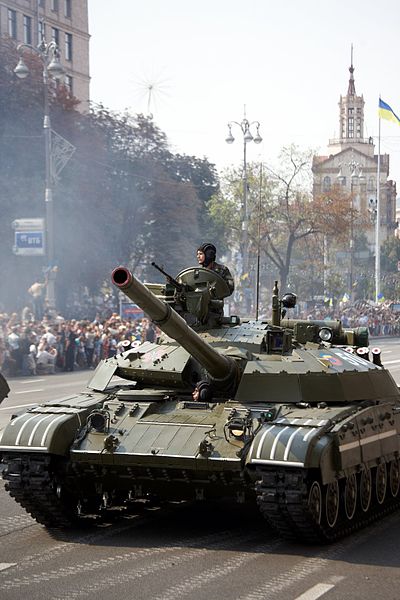
Ukrainian specialized variants
BREM-64
Derived from the Ob’yekt 447T – armored recovery vehicle (ARV) with a light 2.5-tonne crane, a dozer blade, tow bars and welding equipment. A few were built.
BMPV-64
Heavy infantry fighting vehicle (IVF) with completely redesigned upper hull featuring a single rear entry hatch, remote-controlled 30 mm (1.18 in) gun and 34.5 tons heavy. First tried in 2005, but limited production so far for testing and evaluation. The BTRV-64 is an APC version, also semi-experimental.
UMBP-64
New redesigned chassis for several (planned) specialized vehicles (fire support, ambulance air-defense vehicles).
BMPT-K-64
Completely overhauled chassis with 4 axles roadwheels, like the BTR series. The engine is the 5TDF-A/700, for a combat weight of only 17.7 tons. RCWS and a capacity of a platoon or eight equipped infantrymen inside. This prototype did not lead to a production run so far.
BAT-2
A fast combat engineering vehicle sharing the engine, lower hull and suspension with the T-64, but with a large all axis adjustable V-shaped hydraulic front dozer blade, single soil ripper spike at the rear and 2-ton crane on top. 8 crew cabin (five-man sapper squad for dismounted tasks added to the normal crew). 40 ton, only limited production due to a high price tag.
Ukrainian heavy IFV/APC designs
With large surplus of T-64s, the Ukrainian design bureau of the Kharkiv Armor Repair Plant (Zavod 311) tried to use its chassis as a basis for a whole family of combat and support vehicles, aimed for the export market. The engine compartment is moved forward and the fighting compartment removed (as well as the turret). Up to 15 “functional modules”, weighing up to 22 tons can then be inserted, turning the chassis into many new variants. The BMP-64E heavy IFV can carry 10 infantrymen with a remote weapons system. The heavy APC version BTR-64E can carry up to 16 infantrymen, which can exit through large armored double hatches at the rear. A universal supply carrier UMBP-64, a HQ vehicle and a 120 mm (4.72 in) mortar carrier are also on the conversion list. No orders were registered yet.
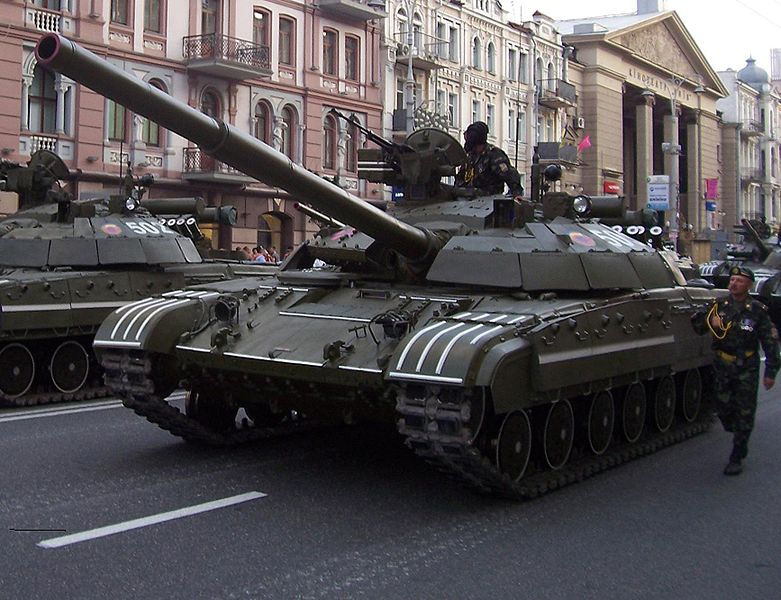 T-64BM Bulat on a rehearsal parade for Independence day at Kiev.
T-64BM Bulat on a rehearsal parade for Independence day at Kiev.
Operators
Soviet Union tanks were passed onto the successor states, Russia, Belarus, Ukraine, and Uzbekistan.
Russia had approximately 4000 tanks in service in 1995, either in reserve or active duty. 2000 were phased out of service and stored for scrapping in the 2000s. According to NATO International and Jen Psaki unmarked T-64 tanks were used by pro-Russian separatists in Ukraine in mid 2014.
Ukraine had 2345 tanks in service as of 1995, but only 2215 in 2005, and around 600 today (modernized), while 900 are in storage for export, conversion and reserve. 100 of these were completely modernized to the T-64BM Bulat standard.
Donetsk People’s Republic Insurgents allegedly deployed around twenty tanks from the Russian army stocks, involved in the summer fighting.
Transnistria Between ten an fifteen T-64BVs are reported in service.
Uzbekistan A hundred T-64s (unknown version) were reported in service as of 2013.
Belarus operated an unknown numbers in the 1990, scrapped since.
The Democratic Republic of the Congo received 50 T-64BV-1 from the Ukrainian Ukrspetsexport in February 2014, the only non-CEI country to operate this tank as of today.
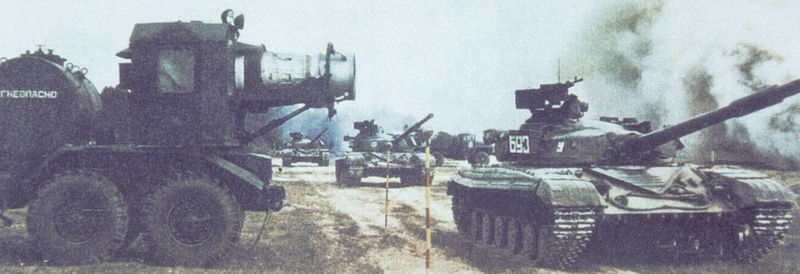
A nuclear decontamination exercise in the 1970s.
Active service
Despite being produced since 1963, the T-64 only entered formal service with the Red Army in 1967, with the 41st Guards Tank Division in the Kiev Military District (according to David Isby) and was only publicly revealed in 1970. It was capable of replacing the IS-3 and T-10 heavy tanks in independent tank battalions. However, the proximity of the division to the factory was not random, but linked with anticipated teething problems during the introduction of these new technologies. Factory support personnel was indeed a regular presence with the division during the service acceptance of this new tank. This period also allowed to train personnel and crews to the new model features, and devise adapted procedures.
At the same time, the simpler T-72 replaced the T-55 and T-62, which formed the bulk of Soviet armored forces, the Warsaw pact and its satellites. The T-64 was definitely a breed apart, introducing many innovations. Due to its high-price tag, it never was intended for export, and was only given to the Red Army elite units and the best trained crews. Entire maintenance and drilling procedures had to be tailored, in a 10-15 years long process. T-64 equipped units were kept in operational readiness in case of a potential outbreak of war in Europe, stationed in East Germany and Hungary.
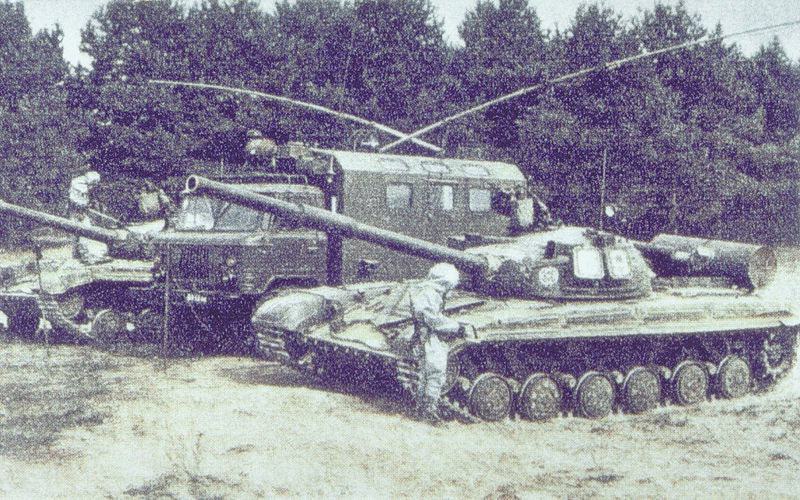
According to official records, the T-64 was never used in the Soviet War in Afghanistan. although it is still possible that a small number of these tanks were tested in “quieter” areas of the front. The Russian T-64s of the 59th Guards Motor Rifle Division in Moldova saw action in May 1992, although the events did not lead to any shots being fired. T-80s participated in the First Chechen War, but the presence of T-64s alongside T-72s and T-62s is only hypothetical.
The Ukrainian civil war
This recent conflict saw the T-64 heavily engaged for the first time, in mid-2014 in the Donbass area. The Ukrainian Army deployed T-64s in the offensive against pro-Russian separatists. Over 20 T-64 tanks were also operated by the military forces of Novorossiya in August. Ukrainian and NATO officials claimed that these T-64s were supplied to the separatists by Russia. Over seventeen T-64s of various configurations (including three T-64BM Bulats) were reported as destroyed by official sources.
The Ukrainian T-64s
76 T-64BM “Bulat” were reported in service in October 2011. The Kharkiv Malyshev Factory upgraded ten T-64B to the BM “Bulat” standard in 2010, and 19 more in 2011 for less than 200 million Hryvnia ($25.1 million). The contract was signed in April 2009. The “Bulat” produced at Kharkiv, then Malyshev Factory, have protection of comparable level to modern western tanks, according to the chief of the design bureau. This is due to the combination of “Knife” reactive armor, and “Warta” active defense system. For its 45 tonnes and 850 hp, the Bulat can reach 70 km/h (43.5 mi) on flat ground for a range of 385 km (239 miles). Its numerous types of 125 mm (4.92 in) ordnance include guided missiles. In February 2014 it was learned that the factory concluded a deal with for 50 T-64BV1 to Congo, the first export to a country outside former USSR operators.
US Army educational “how to fight the T-64 & T-72”
See also :
Made in USSR series, the T-64
Failed tanks series, on the same
T-64 related links
The T-64 on Wikipedia
T-64A specifications
Dimensions (L-W-H)9.1m (6.4m without gun) x 3.38m x 2.3m
(29’8″ (20’10”) x 11’1″ x 7’5″ ft.in)
Total weight, battle ready38 long tonnes, 42 short tons (84,000 lbs)
Crew3 (driver, commander, gunner)
Propulsion5DTF 5-cyl. diesel 700 hp (522 kW), 18.4 hp/t
Speed (depending of versions)From 45 to 60 km/h (28-37 mph)
Range (road/off road)500 km (310 mi), up to 700 with external tanks
ArmamentMain: D-81T 125 mm smoothbore main gun (4.92 in)
Sec: 12.7 mm (0.5 in) NSVT AA HMG, 7.62 mm (0.3 in) PKMT coaxial LMG
Armor16 to 599 mm of equivalent RHA (23.5 in)
Total productionAround 12,000
The T-54/55 were, in 1960, relatively rugged and proven designs, derived from WW2 ideas and concepts. But, with Western countries advancing quickly towards a new generation of battle tanks, the USSR needed to make a bold step forward from its previous designs to keep the edge. By the fall of 1959, the T-62 project was advancing fast at Nizhny Tagil, designed by a young team, and looked revolutionary with its new smoothbore gun.
Alexander Morozov, the chief engineer and father of the T-54/55 family, then headed the Kharkiv factory plant design bureau (KMDB) in Ukraine. He also sought to design the next-generation main battle tank, and also thought a new gun was the necessary upgrade around which the whole new design should revolve. This gun, the 2A46, would be derived from the new generation of Soviet AT smoothbore tracted guns, the 2A45 125 mm (4.92 in). And it would be coupled with other innovations, like an auto-loader, reducing the crew to just three, an upgraded 5DTF 5-cyl. diesel engine, and a completely new and reworked suspensions system, along with upgraded equipment.
But its development took time, and the T-62 was unveiled and mass-produced earlier. The T-64 was eventually built from mid-1960 to late 1980s and upgraded, standing apart as an elite MBT, and precursor of the second generation MBT T-72, which took a great deal from it. Its real successor came in the 1990, after the fall of USSR, with the equally advanced T-90.
Issues
The autoloader controversy
The adoption of an autoloader presented many advantages, but came with some controversy, due to the experience with the less refined T-62 autoloader. It was dangerous for the crew if the assembly quality was not optimal (rounds bouncing around, jammed mechanics), leading to serious injuries and hot poisonous gas exhausts inside the cramped turret, not to mention the problems that arose if the autoloader was inoperable for some reasons. The gunner had to manually load the gun in an uncomfortable and dangerous position, and with a very slow rate of fire (less than one per minute), critical in the heat of battle.
A crew of three
From a strict military point of view, a crew of three could be a great advantage when having limited manpower. France tested this in the 1930s with almost systematic one-man turret configurations (a tradeover due to a depleted male population and poor birth rate after the losses of the Great War), only to find that an overloaded commander was not favorable on the battlefield. A two-man turret with a commander occupied with his usual tasks allowed a three-man tank to remain fully operational and field more tanks with the same amount of trained crews.
But this came at a price, as the crew was also in charge of the tank maintenance and refueling, which was even more exhausting on the complex T-64. Moreover, these duties are also performed at the end of the operations, when the tank crew is physically exhausted, often without an officer, leading to two-men operations and less effective crews on the long run. Maintenance routine, in these cases, had a tendency to be botched or even skipped, which was paid, in return, by higher risks of mechanical failure. These aspects are further exacerbated in active combat operations.
Complexity
Unlike most Russian tanks, simple and rugged, the T-64 was a very complex and unusually care-sensitive machine. This, combined with summary maintenance habits and reduced crew, resulted in a very high breakdown rate at the beginning. The brand new suspension system, a quite advanced design, necessitated the permanent presence of teams of civilian mechanics from factories to assist the unit for the first years after its adoption and delayed a widespread adoption in operational frontline units until the 1970s, and only with proper maintenance procedures. The engine itself was also troublesome, and entire units stationed in East Germany and Hungary were sometimes depleted of 30 tanks in a single year, the equivalent of a whole battalion. Complaints numbers reached the military wing of the central committee. Alexander Morozov himself was blamed, but the military school was able to train a new generation of young officers, able to deal with all aspects revolving around this new tank. This generation was able to make the transition between the “old school mass produced” generation MBTs, to those accustomed to a fewer and high engineered third-generation main battle tanks, like the T-80 and T-90, plus better-trained crews, but the T-64 triggered all this.
The Ukrainian variants (1990-2000s)
The end of the Cold War allowed the T-64 to keep up with the latest technologies, right up to the XXIst century. These developments were greatly helped by the presence of the original factory and its numerous facilities on Ukrainian soil.
The T-64BM2
This version received a brand new 57DFM multi-fuel engine capable of 850 hp (625 kW), a new 1A43U fire control system, a new 6ETs43 autoloader and a system enabling the use of the light 9M119 AT missile (“AT-11 Sniper”). Armor is upgraded to the Kontakt 5 ERA standard.

The Ukrainian T-64BM Bulat in maneuvers.
The T-64U
This model is based on the latter, but received a new 1A45 fire control system borrowed from the T-80U/T-84, the tank commander PNK-4SU and TKN-4S all-weather NV optics, and an anti-aircraft PZU-7 AA sight for the heavy machine gun. The tank commander is given the possibility to fire the gun directly if the gunner was incapacitated. The standard protection is provided by a Kontakt-5 explosive reactive armor set, and apparently upgraded only on a few prototypes. Both the BM2 and U are in the process of being re-engineered with the new 6TDF 1000 hp (735 kW) engine.
The T-64BM Bulat
Based on the BM2, this version integrates the Ukrainian designed Knozh reactive armor, a well improved version of Kontakt-5, apparently giving better overall protection against tandem warheads, and also equipped with the new Ukrainian main gun 125 mm (4.92 in) gun KBA3. It is also equipped with the advanced TO1-KO1ER night sight and compatible with the Ukrainian KOMBAT missile system, which uses tandem warheads. It basically brings the T-64B to the standard of the T-84 with “Nozh” reactive armor, 9K120 “Refleks” missile (NATO code “AT-11 Sniper”), 1A45 “Irtysh” fire control, TKN-4S commander’s sight and PZU-7 AA HMG sight plus TPN-4E “Buran-E” night vision and a 6TDF 1000-hp (735 kW) engine.
Production & variants
Due to the program secrecy, the sources are differing considerably about the total production, at least in the initial period of 1963-1967. In practice, the first T-64s had the same 115 mm (4.53 in) smoothbore gun as the T-62, but mass-production models were all equipped with the 125 mm (4.92 in) gun, compatible with T-72 ammunition. The T-64 was, however, much more complex and costlier than the T-72, and did not see much active service outside the USSR or Russia.
Experimental variants
- T-64R (remontirniy or rebuilt)/Ob\’yekt 432R (1977-1981), tested with the T-64A standard, but with the 115 mm (4.53 in) gun.
- T-64T (1963), testing a GTD-3TL 700 hp (515 kW) gas turbine.
- Ob’yekt 436, alternative version with the V-45 engine, three prototypes built.
- Ob’yekt 437 prototype for the B1, without the FCS and only carrying 37 shells.
- Ob’yekt 438/439 based on the Ob’yekt 434, but with the V-45 diesel engine.
- Ob’yekt 446B prototype for the BK and B1K command versions.
- Ob’yekt 447, prototype for the T-64B series, with the 9K112 “Kobra” system and a1G21 gunsight.
- Ob’yekt 447AM-2, prototype for the BM2 series. Kontak-5 ERA, rubber skirts, 1A43U FCS, 6ETs43 loader, 9K119 missile enabled, 5TDFM engine.
- Ob’yekt 447AM-1, prototype for the Ukrainian “Bulat” version.
- Ob’yekt 476, five prototypes with the 6TDF engine, prototypes for T-80UD development.
- T-55-64, experimental hybrid of an upgraded T-55 with the hull and chassis of a T-64, and “Kontakt-1” ERA.

Ukrainian specialized variants
BREM-64
Derived from the Ob’yekt 447T – armored recovery vehicle (ARV) with a light 2.5-tonne crane, a dozer blade, tow bars and welding equipment. A few were built.
BMPV-64
Heavy infantry fighting vehicle (IVF) with completely redesigned upper hull featuring a single rear entry hatch, remote-controlled 30 mm (1.18 in) gun and 34.5 tons heavy. First tried in 2005, but limited production so far for testing and evaluation. The BTRV-64 is an APC version, also semi-experimental.
UMBP-64
New redesigned chassis for several (planned) specialized vehicles (fire support, ambulance air-defense vehicles).
BMPT-K-64
Completely overhauled chassis with 4 axles roadwheels, like the BTR series. The engine is the 5TDF-A/700, for a combat weight of only 17.7 tons. RCWS and a capacity of a platoon or eight equipped infantrymen inside. This prototype did not lead to a production run so far.
BAT-2
A fast combat engineering vehicle sharing the engine, lower hull and suspension with the T-64, but with a large all axis adjustable V-shaped hydraulic front dozer blade, single soil ripper spike at the rear and 2-ton crane on top. 8 crew cabin (five-man sapper squad for dismounted tasks added to the normal crew). 40 ton, only limited production due to a high price tag.
Ukrainian heavy IFV/APC designs
With large surplus of T-64s, the Ukrainian design bureau of the Kharkiv Armor Repair Plant (Zavod 311) tried to use its chassis as a basis for a whole family of combat and support vehicles, aimed for the export market. The engine compartment is moved forward and the fighting compartment removed (as well as the turret). Up to 15 “functional modules”, weighing up to 22 tons can then be inserted, turning the chassis into many new variants. The BMP-64E heavy IFV can carry 10 infantrymen with a remote weapons system. The heavy APC version BTR-64E can carry up to 16 infantrymen, which can exit through large armored double hatches at the rear. A universal supply carrier UMBP-64, a HQ vehicle and a 120 mm (4.72 in) mortar carrier are also on the conversion list. No orders were registered yet.
 T-64BM Bulat on a rehearsal parade for Independence day at Kiev.
T-64BM Bulat on a rehearsal parade for Independence day at Kiev.Operators
Soviet Union tanks were passed onto the successor states, Russia, Belarus, Ukraine, and Uzbekistan.
Russia had approximately 4000 tanks in service in 1995, either in reserve or active duty. 2000 were phased out of service and stored for scrapping in the 2000s. According to NATO International and Jen Psaki unmarked T-64 tanks were used by pro-Russian separatists in Ukraine in mid 2014.
Ukraine had 2345 tanks in service as of 1995, but only 2215 in 2005, and around 600 today (modernized), while 900 are in storage for export, conversion and reserve. 100 of these were completely modernized to the T-64BM Bulat standard.
Donetsk People’s Republic Insurgents allegedly deployed around twenty tanks from the Russian army stocks, involved in the summer fighting.
Transnistria Between ten an fifteen T-64BVs are reported in service.
Uzbekistan A hundred T-64s (unknown version) were reported in service as of 2013.
Belarus operated an unknown numbers in the 1990, scrapped since.
The Democratic Republic of the Congo received 50 T-64BV-1 from the Ukrainian Ukrspetsexport in February 2014, the only non-CEI country to operate this tank as of today.

A nuclear decontamination exercise in the 1970s.
Active service
Despite being produced since 1963, the T-64 only entered formal service with the Red Army in 1967, with the 41st Guards Tank Division in the Kiev Military District (according to David Isby) and was only publicly revealed in 1970. It was capable of replacing the IS-3 and T-10 heavy tanks in independent tank battalions. However, the proximity of the division to the factory was not random, but linked with anticipated teething problems during the introduction of these new technologies. Factory support personnel was indeed a regular presence with the division during the service acceptance of this new tank. This period also allowed to train personnel and crews to the new model features, and devise adapted procedures.
At the same time, the simpler T-72 replaced the T-55 and T-62, which formed the bulk of Soviet armored forces, the Warsaw pact and its satellites. The T-64 was definitely a breed apart, introducing many innovations. Due to its high-price tag, it never was intended for export, and was only given to the Red Army elite units and the best trained crews. Entire maintenance and drilling procedures had to be tailored, in a 10-15 years long process. T-64 equipped units were kept in operational readiness in case of a potential outbreak of war in Europe, stationed in East Germany and Hungary.

According to official records, the T-64 was never used in the Soviet War in Afghanistan. although it is still possible that a small number of these tanks were tested in “quieter” areas of the front. The Russian T-64s of the 59th Guards Motor Rifle Division in Moldova saw action in May 1992, although the events did not lead to any shots being fired. T-80s participated in the First Chechen War, but the presence of T-64s alongside T-72s and T-62s is only hypothetical.
The Ukrainian civil war
This recent conflict saw the T-64 heavily engaged for the first time, in mid-2014 in the Donbass area. The Ukrainian Army deployed T-64s in the offensive against pro-Russian separatists. Over 20 T-64 tanks were also operated by the military forces of Novorossiya in August. Ukrainian and NATO officials claimed that these T-64s were supplied to the separatists by Russia. Over seventeen T-64s of various configurations (including three T-64BM Bulats) were reported as destroyed by official sources.
The Ukrainian T-64s
76 T-64BM “Bulat” were reported in service in October 2011. The Kharkiv Malyshev Factory upgraded ten T-64B to the BM “Bulat” standard in 2010, and 19 more in 2011 for less than 200 million Hryvnia ($25.1 million). The contract was signed in April 2009. The “Bulat” produced at Kharkiv, then Malyshev Factory, have protection of comparable level to modern western tanks, according to the chief of the design bureau. This is due to the combination of “Knife” reactive armor, and “Warta” active defense system. For its 45 tonnes and 850 hp, the Bulat can reach 70 km/h (43.5 mi) on flat ground for a range of 385 km (239 miles). Its numerous types of 125 mm (4.92 in) ordnance include guided missiles. In February 2014 it was learned that the factory concluded a deal with for 50 T-64BV1 to Congo, the first export to a country outside former USSR operators.
US Army educational “how to fight the T-64 & T-72”
See also :
Made in USSR series, the T-64
Failed tanks series, on the same
T-64 related links
The T-64 on Wikipedia
T-64A specifications
Dimensions (L-W-H)9.1m (6.4m without gun) x 3.38m x 2.3m
(29’8″ (20’10”) x 11’1″ x 7’5″ ft.in)
Total weight, battle ready38 long tonnes, 42 short tons (84,000 lbs)
Crew3 (driver, commander, gunner)
Propulsion5DTF 5-cyl. diesel 700 hp (522 kW), 18.4 hp/t
Speed (depending of versions)From 45 to 60 km/h (28-37 mph)
Range (road/off road)500 km (310 mi), up to 700 with external tanks
ArmamentMain: D-81T 125 mm smoothbore main gun (4.92 in)
Sec: 12.7 mm (0.5 in) NSVT AA HMG, 7.62 mm (0.3 in) PKMT coaxial LMG
Armor16 to 599 mm of equivalent RHA (23.5 in)
Total productionAround 12,000
